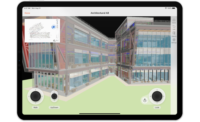
The largest construction project in Europe leans so heavily on mobile technology that its managers are changing safety policies to protect employees with "mobile-only" zones in which workers also can test new mobile apps for construction.
"You must have your full attention on the surroundings in order to stay safe on a jobsite," says Ailie MacAdam, central-section delivery director for Bechtel, which is the lead contractor for the 118-kilometer-long Crossrail railway project in southeast England.
With mobile devices and iPads more common on jobsites, Bechtel implemented "mobile-device zones" to keep heads-down workers safe from potential harm. "They're at convenient, logical, preplanned locations," says MacAdam. If workers are caught using mobile technology outside of a mobile zone, the worker is cited with what Bechtel calls a "near miss," she says.
This tactic discourages mobile use in dangerous areas. "Technology has changed all aspects of how we work as engineers," MacAdam adds. "Engineers now have to be at their computers to do 75% of their work."
Mobile tech gets construction engineers closer to the work, says Christian Reilly, manager of Bechtel's EPC systems. In the past few years, the company has rolled out more than 1,000 iPads for projects. Its internal IT department has built more than 50 custom apps in recent years. One is Bechtel's Concrete Monitor app, which uses sensors placed in the formwork before concrete is poured.
"The sensors monitor the curing process," says Reilly. "You can get ahead of any quality issues to see what is happening in real time inside the pour."
Using tablets and new apps on-site has become such a large part of the company's workflow that their use has created new safety issues, says Reilly.
The mobile zones also help workers to test new technology on-site, such as Bentley Systems' document validation project. Site-plan PDFs are printed from Bentley's ProjectWise, but data matrix codes are also printed on the plans to allow engineers to use an off-the-shelf bar-code scanner app, such as "i-nigma," to check the status of the drawing, says Jo Write, a Bentley Systems product manager.
"Crossrail came to us and said, 'We need a quick-and-easy way to make sure we're looking at the same document,' " says Write. Printed on the drawings, the data matrix code ties back to an explicit URL that is the single source of truth for the most up-to-date site drawings, says Write. "You can hover over the code, and it takes you to a screen that says if it's up to date or not."
Reilly says Bechtel looks to the consumer market to get a lead on how people interact with mobile devices. "We're applying those trends to the construction and engineering space," Reilly says.
Bechtel's next innovation is to harnass a consumer marketing strategy known as social local mobile (SoLoMo). The inspiration is a Starbucks app that pushes coupons directly to consumers' phones when they enter a Starbucks store.
"SoLoMo will allow us to identify nearby hazards on-site by using global information systems and GPS. The system will warn workers when they enter an area that has safety risks associated with it," says Reilly.





